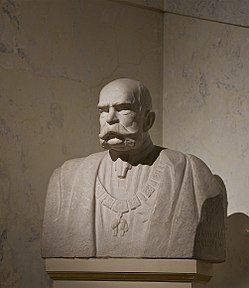The bust of the emperor
The Bust of the Emperor is a novella by Joseph Roth , which appeared in December 1934 under the title "Le buste de l'empereur" and was preprinted from July 27 to August 1, 1935 in the German-language anti-fascist daily Pariser Tageblatt . The work was published by Kiepenheuer & Witsch in Cologne in 1964 .
content

The inhabitants of the east Galician village Lopatyny - located between Przemysl and Brody - respect and love their Count Franz Xaver Morstin. You have every reason to. Because that violent willingness to help the needy is the only distraction of the grand seigneur . Coming from an old Polish family - with roots in Italy - the Count feels neither a Pole nor an Italian, but as an Austrian , i.e. as a supranational person . If someone from the aristocratic neighborhood speaks disrespectfully about Emperor Franz Joseph in his presence , he simply no longer associates with the prankster. On the occasion of an imperial maneuver, His Imperial and Royal Apostolic Majesty spends a few days in the Count's castle . Soon after, a farm boy from the area delivers a hand- carved sandstone bust of the beloved ruler to the count. During the war , the count hides the bust in the castle cellar. After the war, the Count had to watch a copy of St. Stephen's Crown being desecrated in the American Bar in Zurich . When he got home in Lopatyny, the count had the bust of the deceased ruler put up again in front of his castle. One day the voivode of Lvov , formerly known as Lviv , came to Lopatyny on an inspection tour through his sphere of influence. Conclusion of the flying visit: The bust must not remain on the ground in Poland. When the voivode is gone, the bust is buried with the participation of the villagers and buried with all honors. The count then goes to the Riviera and does not want to be buried in the family crypt later, but right next to the grave with the bust of the emperor.
Quote
The old Austro-Hungarian monarchy by no means died from the hollow pathos of the revolutionaries, but from the ironic disbelief of those who should have been their faithful supporters .
reception
In the novella, Joseph Roth depicts the past almost as if in a fairy tale . With the idyllic village of Lopatyny, far from modern civilization, he creates the representative microcosm of an ideal, utopian multi-ethnic society. Social or national conflicts cannot arise in the patriarchal-feudalist community because everyone accepts their status and that of their fellow human beings and respects the sovereignty of Emperor Franz Joseph.
On the socio-political level, the “bust of the emperor” can be understood as a plea for the restoration of the monarchy. Beyond the resigned realization that Franz Joseph and his kingdom are dead, Morstin hopes for their resurrection. After all, the stone emperor cannot rot, that is, the Austrian idea embodied in him can never become invalid. On their basis, suggests Roth, a whole new empire could be established.
On a psychological-biographical level, Roth can be found in the figure of Count Morstin, wandering homelessly. He never knew his father and all his life longed in vain for home and fatherly security, a longing that he increasingly projected onto the emperor Franz Joseph, whom he had glorified, in exile. Towards the end of his life he tried again to cope with his father trauma and personally buried his “two” fathers, the dead imperial and the missing corporal, with the emperor's bust on a symbolic level.
literature
source
- Fritz Hackert (Ed.): Joseph Roth. Works. Volume 5: Novels and Stories. 1930-1936. Pp. 655–676: The bust of the emperor. Novella. 1935. With an afterword by the editor. Book guild Gutenberg, Frankfurt am Main 1994, ISBN 3-7632-2988-4 .
Secondary literature
- Helmuth Nürnberger : Joseph Roth. In self-testimonials and picture documents. Rowohlt-Taschenbuch-Verlag, Reinbek near Hamburg 1981, ISBN 3-499-50301-8 ( Rowohlt's Monographs 301).
- Thorsten Juergens: Critical aspects of society in Joseph Roth's novels. Universitaire Pers, Leiden 1977, ISBN 90-6021-411-0 ( German and English series of the University of Leiden 16).
- Ursula Renner: A memorial is buried. The "Bust of the Emperor" by Joseph Roth. In: Bärbel Götz, Ortrud Gutjahr, Irmgard Roebling (Eds.): Schwewiegenes Ich. On the inexpressible in autobiographical texts. Centaurus, Pfaffenweiler 1993, ISBN 3-89085-734-5 , pp. 125-146.
- Gero von Wilpert : Lexicon of world literature. German authors A - Z. 4th, completely revised edition. Kröner, Stuttgart 2004, ISBN 3-520-83704-8 , p. 519.
- Wilhelm von Sternburg : Joseph Roth. A biography. Kiepenheuer & Witsch, Cologne 2009 (2nd edition), ISBN 978-3-462-05555-9 .